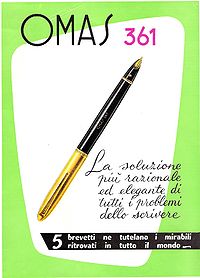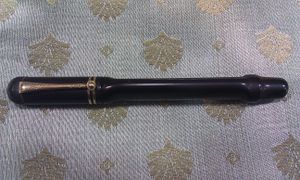Differenze tra le versioni di "Omas/en"
(Nessuna differenza)
| |
Versione delle 10:16, 3 gen 2013
OMAS was founded in 1925 and is an historical Italian fountain pen brand. Since then, although with varying fortunes and many changes in ownership occurred after the death of its founder, the brand has always remained active in the market. Property passed in 2000 to the French luxury brand Louis Vuitton, who sold the company to Chinese brand Xinyu Hengdeli in October 2007.
During its history OMAS made some considerable technical innovations and always had a very high production quality, making pens that were probably the best in the Italian production. And also if their more famous model are almost always showing a clear imitation of the stylistic characteristics of foreign models, they were often more beautiful and better quality than the originals. The absolute quality of the OMAS production, and the refinement of the celluloid used by this brand, makes OMAS pens among the most sought after by collectors.
| Omas |
|---|
| Brand pages |
| Brand advertising |
| Brand photos |
| Instructions sheet |
| Other documents |
| Patents |
History

OMAS was founded in Bologna in 1925 by Armando Simoni. In 1919, Simoni, just married, opened a workshop in Via S. Vitale producing film reels and safeties mechanisms.[1] Shortly Simoni began to produce spare parts for the most important fountain pen brands. They had a considerable success and customer demands grew making the activity expand, so a whole pens productions began. This early years models, not marked OMAS were hard rubber pens with safety or lever filler, made as a clear imitation of Waterman models.
But it was only in 1925, when the construction of the factory in Via degli Orbi was completed that Officine Meccaniche Armando Simoni was born, and the acronym OMAS become the brand under which fountain pens were marketed. The first OMAS major model was the Penna del dottore, patented in 1927. It was a lever filler hard rubber model having a compartment inside the barrel that contained, in addition to the filling mechanism, a thermometer to measure temperature, kept separate from the rest by a metal partition. In the same year OMAS got another patent for the metal joint used for the realization of desk pens, for which the company was one of the main Italian producers.
The OMAS initial production is characterized by some button filler Flat top models, that were a clear imitations of the Duofold. But some of these sported original technical solutions, like the second version of the Penna del dottore in which the thermometer was again hosted by the body of the pen, or the penna del calligrafo, directed to the use by calligraphers, which was equipped with a special section that can be unscrewed and replaced, allowing an easy nib change.
In this early period there is trace of some Parker models (Duofold and Thrift Time) marked Geo. S. Parker - fabbricato in Italia whose production is attributed to OMAS. There is a debate about these pens, whether they are a real production on Parker commission, made to circumvent the restrictions by the autarkic policies of the fascist regime, or it is a semi-official production ordered by the Parker agent for Italy, Edoardo Webber, which was facing a supply shortage, or whether it really was a clandestine (and illegal) production. As there are no documents, and no other findings than proof of a subsequent relationships between Simoni and Webber for the production of Saratoga fountain pen, there is any definitive conclusion.
OMAS was between first Italian companies to move production to celluloid between the late '20s and early '30s. The company produced its fountain pen in classic colors as jade green or lapis blue as well as other interesting variations of marbled colors. Among this early celluloid production some pens stand out, similar to the previous Duofold imitations, but with tapered ends, probably born in the early 30s years with the establishment of the streamlined style; only a few examples of this production are known. The start of production for Minerva branded pens can be traced back more or less to this period. This was the only official Omas sub-brand,[2] dedicated to second tier pens production, that nevertheless were of excellent quality.
The turning point in the OMAS production was in 1932, when the pen that remained for decades one of the brand flagship models, the Extra, was introduced. It was a lever filler made using a multifaceted celluloid, decorated with a wide band on the cap, engraved with a greek shaped pattern. The pen was produced in four different sizes and launched with the slogan creazione di artista e di scienziato[3] that was accompanied by an extensive advertising campaign.
Although Extra was very similar to the Eversharp Doric, introduced a few months before, it is still controversial whether it is an imitation, since the time between the two pens is rather short. OMAS estimators point out that given the short time between the release of two pens, it would not possible to create production facilities if the Extra was a Doric imitation. but there is no information supporting this claim, and many evidence of the company abit to imitate american models. Whether the Extra can be considered an imitation or not, for its materials, quality and workmanship, it is at the same level, if not better, than the models which it may have been inspired. The pen was an huge success and remained in production until 1946, albeit with minor stylistic changes, like the introduction of a smooth version and the substitution of the wide band with three tiny rings.
In 1936 was introduced and patented a new model, the Lucens, with an original (for Italy), loading system, called stantuffo tuffante.[4] The mechanism is essentially identical to the one used by Dunn about 15 years earlier, although it is not possible to determine whether it was a copy or an original independent creation. Despite this the Lucens is one of the most beautiful pens ever made, especially for the beauty of the different kind of semi-transparent celluloid used to made it, giving a direct view of the ink level.
Initially produced only in the smooth version, the Lucens was soon joined by the Extra Lucens made with the same multifaceted body of the Extra, but with the new loading system. In 1938 the previous wheel clip (very similar to the Doric one) was replaced by an arrow shaped clip, a clear imitation of that used by Parker with the Vacumatic model. The Vacumatic imitation was even more evident for a substantially identical engraving of the nib (with an arrow drawing). Despite these imitations the Extra Lucens is superior from any point of view (technical, aesthetic and for manufacturing quality) than any Vacumatic and it's probably the best model produced by OMAS.
With the progress of World War II came also a shortage of raw materials, particularly for gold nib, and like most of the European companies OMAS had to resort to some steel alloy. The one used by OMAS was called Permanio, and was advertised as having a better durability even when compared to gold. But this alloy proved to be one of the most susceptible to corrosion, and today Permanio nibs are very rare and have a much higher value of their analogues in gold.
After the war OMAS resumed production with a change of style, producing pens with a new ogival shape, and adopting the piston filler. In 1946 the Extra line was completely restyled, the wheel clip was maintained, but were used three ring on the cap as decoration, and the filling system was changed to piston filler, with a transparent section for ink level display. They were produced in three sizes, small, medium and large, identified respectively by the numbers 555, 556 and 557.

In 1948 OMAS made one of the most significant invention in the world of the Italian fountain pen production, the 361 model. This pen was the answer to the Parker 51 success. The originality of this more is in the central position of the nib, mounted along pen axis, protected by a cover left open on one side. Depending on the position of the open side, the nib can be almost completely covered over the top, resulting in a rigid writing, or left wide open, allowing a flexible writing. This system was very functional, allowing bot firm and flexible writing, and it seems that Parker tried several times to acquire this patent(nº US-2565667) from OMAS.
The 361 introduction led to a number of new features both in the stylistic and technical aspects, because for its production were adopted the new ogival lines, with a single decorative ring on the cap and the piston filler was used as filling system for all the OMAS production excepted the Extra Lucens who stayed with the stantuffo tuffante, arrow clip and three rings on the cap, remaining in production for all the '50s, produced without the two-tone nib, and only in medium and large sizes and all black color.
Two special models, the 351 and 352 were introduced about the 1950 and remained in production for a very short time. These pens and extremely rare, and almost impossible to find. They were piston filler but the body was made by gluing alternate sections of transparent and colored celluloid, to achieve an extraordinary result of transparent barrel in alternating sections.
During the same period the 361 ogival shapes were adopted also for the other models, with the introduction of the Lucens Ogiva and new versions of the Extra (referred as 555/S, 556/S e 557/S). These pen were built in celluloid, with a red or yellow transparent window, with some variants equipped with metal caps. But also the traditional multifaceted shapes were kept, both for the 361 for the new Extra series with new models called 555/F, 556/F and 557/F.
In the following years OMAS production continued with piston filler celluloid pens and the company introduced the new VS and CS models. But after the Armando Simoni death in 1958 there were not significant advances, although in recent decades various new models have introduced, trying to chase the high end market, and bringing back in production some models very similar to the celluloid ones of the '30s. The company is still on the market, although it was selled by Simoni heirs to french luxury brand Luis Vuitton that recently selled it to chinese brand Xinyu Hengdeli.
Chronology
| Year | Event |
|---|---|
| 1925 | OMAS is founded |
| 1927 | the Penna del dottore was patented |
| 1932 | Introduced the Extra model |
| 1934 | Introduced the Minerva Classica model |
| 1936 | Introduced the Lucens and Extra Lucens with the stantuffo tuffante loading system |
| 1936 | Band on smooth Extra cap was replaced by three tiny rings |
| 1938 | Introduced the arrow clip on Extra Lucens model |
| 1940 | Introduced the Permanio nib |
| 1940 | Band on faceted Extra cap was replaced by three tiny rings |
| 1946 | Restyling of the Extra model, replaced by a new version with stantuffo tuffante filling system |
| 1948 | Introduced the 361, restyled the Extra models |
| 1950 | Introduced the 351 and 352 models |
Models
| Model | Period | Dimension/Version |
|---|---|---|
| Extra | 1932 | XX, ? |
| Lucens | 1936 | XX, ? |
| 361 | 1948 | XX, ? |
Notes
- ↑ there is a registration for the Officine Meccaniche di Precisione Simoni Armando in 1922.
- ↑ these are the only pens marketed directly by OMAS, although there are many other productions, often directly derived from Minerva models, known to be made by Omas on behalf of other companies, as the production for Ercolessi, the Saratoga or the Scotland and perhaps also the Nettuno Superba, and double pen models like the Itala and the Zerollo.
- ↑ meaning creation by artist and scientist.
- ↑ meaning diving piston.
External references
- http://www.omas.net/ Official web site, irrelevant for historical informations
- http://www.rickconner.net/penoply/misc.19.html An article with a few historical informations
- http://www.rickconner.net/penspotters/omas.html An article with a few historical informations
- http://www.pennamagazine.com/load_detail.aspx?id=5&nt=stilo Nice article on Duofold-like models
- http://www.pennamagazine.com/load_detail.aspx?id=4&nt=stilo Other article on Duofold-lile models

